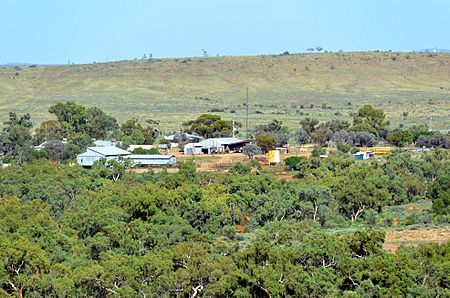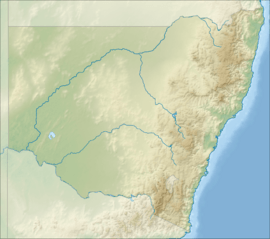Fowlers Gap Arid Zone Research Station facts for kids
Quick facts for kids Fowlers Gap Arid Zone Research StationFowlers Gap, New South Wales |
|
|---|---|

Overview of the station
|
|
| Area | 38,888 hectares (96,090 acres) |
| Location | 112 km (70 mi) north of Broken Hill |
| County | Mootwingee |
| Parish | Hume |
| Website | Fowlers Gap Arid Zone Research Station |
| Designations | |
|---|---|
| Official name | Fowlers Gap Field Station |
| Type | Natural |
| Criteria | C1. |
| Designated | 28 May 1996 |
| Reference no. | 19186 |
The Fowlers Gap Arid Zone Research Station is a special place in New South Wales, Australia. It's a teaching and research facility run by the UNSW Australia (UNSW). This station is located in Fowlers Gap, which is in the far north-west of the state.
It's about 112 kilometers (70 miles) north of Broken Hill. The station covers a huge area of 38,888 hectares (about 96,094 acres). Scientists use this land to study many things, from animals and plants to ancient fossils and the environment. Even art and design students visit to use special studios for their field trips.
Contents
What Makes Fowlers Gap Special?
Fowlers Gap has been owned by UNSW since 1966. It's managed by the UNSW Faculty of Science. This station helps scientists learn about dry, desert-like environments. They especially study how human activities affect these areas. Fowlers Gap is the only research station of its kind in the arid (dry) zone of New South Wales.
Scientists have been collecting data here for over 30 years. This long-term information helps them understand changes in the environment. The station has places for groups to meet, sleep, and even camp. This makes it great for visiting researchers and small conferences.
Who Uses the Station?
Many different groups use Fowlers Gap for research. These include departments from UNSW like:
- Biological, Earth & Environmental Sciences
- Civil and Environmental Engineering
- College of Fine Arts
- The Faculty of Built Environment
- The Centre for Photovoltaic Engineering
- The Centre for Remote Sensing and GIS
Other universities and government groups also use the station. These include Macquarie University, the University of Sydney, and CSIRO. They study things like sustainable tourism and how landscapes change over time.
Learning and Exploring
Fowlers Gap is not just for research; it's also a big classroom! Students from UNSW and other schools visit for field trips. People from all over Australia and other countries come to see it. The station has even been featured in TV shows and newspaper articles.
It's full of amazing wildlife and beautiful scenery. You can find different types of rocks and land formations. The area also has a rich human history. There are important Indigenous sites, like a stone tool quarry. You can also see artifacts from decades of scientific research.
The station has natural waterholes and creeks that flow after rain. Several large dams hold water, even during dry periods. Sheep are also raised here, which helps support the station financially.
Why Fowlers Gap is Important
The Fowlers Gap Station and its records are very important for research and education. In May 1996, it was added to the former Register of the National Estate. This means it was recognized as a significant place.
It's the only research station in the dry zone of New South Wales. It's also the only one in the winter rainfall arid zone of Australia. This makes it a unique place to study.
Scientists know a lot about the small creatures (invertebrates) living here. They also have studied many other parts of the natural environment. Some areas have been watched and photographed for over thirty years. This gives scientists an amazing record of how the environment changes. More than 100 scientists have done research here, leading to many scientific papers.
Gallery






